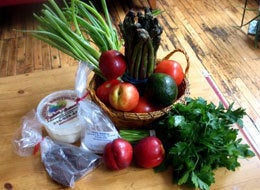
According to French chefs, and articulated by Jacques Pépin in his classic cook book written with Julia Child, there are three reasons chefs turn (excuse me, tourne) vegetables: "The purpose of 'turning' vegetables is more than just aesthetic," explains Jacques in the margin of Cooking At Home. "This technique produces pieces of a uniform size which can cook evenly, and allows them to be tossed and rolled easily in a sauté pan, so that they will glaze and color on all sides." Jacques, mon cher ami. With the utmost respect, I must take issue with all three reasons, and propose a reason to trump all other reasons: the real purpose of turning vegetables is to put culinary students through hell.
For those of you not familiar with tournage de legumes (French for "the turning of the vegetables," which I always thought sounded like an Elizabethan contest of some sort), it is a technique of shaping vegetables, usually the potato, carrot, and turnip, into barrel-like shapes (or, for we Americans, a slightly elongated football). Each turned vegetable must have seven sides. Why seven, you ask? To know this is to have complete insight into the brain of the person with the silly white tall hat, which is impossible. Why turn these particular vegetables, which are arguably the least respected in all of French cuisine? In La Physiologie du Gout, Brillat-Savarin wrote, "I appreciate the potato only as a protection against famine, except for that I know of nothing more eminently tasteless." Waverly Root, journalist and food historian, notes that the turnip ranked so low in the esteem of those in the Middle Ages that "it became popular to pelt unpopular persons with turnips (tomatoes being not yet available)."
Despite these seemingly arbitrary and unanswerable conditions, the practice of tournage became so widespread in the French kitchen that it was necessary to designate a different name for each length:
1) Bouquetiere (3 cm in length)
2) Cocotte (5 cm)
3) Vapeur (6 cm)
4) Chateau (7.5 cm), and
5) Fondante (8-9 cm)
Like the practice itself, these names are un peu fou, or, in English, "idiotic." First we have the tiniest cut, (1) the "flower seller."
One step up, we've got (2) the "casserole pot."
Then (3) "steam."
Then (4) "castle."
Then an adjective (5): "Something feminine that is melting."
Ah, but of course.
Imagine the conversations that must have taken place in traditional French kitchens, years ago. "New cook, you gave me four potatoes cut into casserole pot shapes! Fool, I asked you for the steam shape!" "But, monsieur, the shape of steam?"
When first introduced to tournage, I tried to come up with reasonable explanations for the nomenclature. The most obvious is that the name is reminiscent of the shape, but only someone with severe macular degeneration would think that a castle looked like a barrel-shaped carrot. Did the terminology have to do with cooking method? Perhaps a vapeur shape was traditionally steamed, and a cocotte shape cooked in a certain type of pot. But did that make cooking the bouquetiere shape the sole province of French flower sellers? ("I sell flowers during the day, but moonlight as a miniscule-barrel-shaped-potato cooker.")
Alert to the challenge, I first searched the internet to discern which masochistic chef came up with this technique, revealing blogs of culinary students lamenting the practice. I next turned to the school's library, which has hundreds of food-related books for the serious researcher. I searched through the works of Carême and Escoffier, but found no mention in any of their books (though I admit that, what with my high school French, I may have skipped over Carême's explanation of his melting turnip). The school librarian had no idea where the practice originated, but parroted back to me Jacques' original reasons: 1) the shapes are aesthetically pleasing, 2) as they are of equal size, they will cook evenly, and 3) it's easier to cook the vegetables evenly on all sides because they roll around in the pan.
May it please the court:
1) The shapes are aesthetically pleasing: A potato shaped like a rose. A turnip carved into a scroll. A carrot pared down into a delicate bird. But a barrel?
2) They ensure even cooking: A group composed of any equal sized shapes will cook evenly. (Derisive chuckles from the gallery.)
3) It is easier to cook turned vegetables because they roll around in the pan: If so, let's all just use a melon-baller.
Riot in the courtroom, the defense is carried out triumphantly in a large Creuset.
Nevertheless, and despite my protest, I had to spend the past few months refining my tournage. I'd lug home sacks of potatoes and whittle away until I'd find myself holding wimpy 1mm square piece of potato, with a mountain of shavings in the sink. I dreamed of a room of vegetable lathes, worked by hobbit-like creatures that produced perfect, mathematically precise seven-sided tournes, each at an angle of 51.43 degrees to its neighbor.
Now, after weeks of practice, and countless root vegetables, my tournage is adequate. "Pas mal," sniffed my chef. "But don't relax. Next week, pommes soufflés, which have reduced strong men to whimpering fools."
So like that garden pest beloved of the French, the escargot, I climb the Parnassus of haute cuisine, one miniscule centimeter at a time. It does give me a teeny bit of joy to see my technique improving, and though I've yet to see a turned potato in a restaurant, I'm keeping my eyes (and my pommes de terres) peeled. And one day in the future, when I've earned my toque, when I'm standing at the head of the kitchen brigade, sous-chefs trembling at my gaze, I'll bark out, "Seven sides! Why? I don't know why! Because that's the way it's been done for centuries!"
To illustrate the importance of respecting our forebears, I may even wind up letting a turnip fly at the offending imbecile.